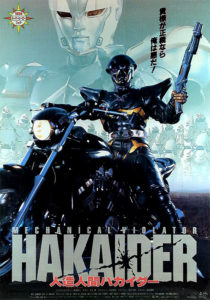Director: Keita Amemiya
Cast: Yuji Kishimoto, Mai Hosho, Yasuaki Honda, Dai Matsumoto, Kazuhiko Inoue, Sumisu Andi
Running Time: 51/71 min.
By Henry McKeand
There’s cerebral, lore driven science fiction, and then there’s something like Mechanical Violator Hakaider: a lizard-brained action fantasy with little patience for traditional world-building or character development. Directed by Keita Amemiya (Zeiram, Kamen Rider ZO) and based on the 1972 tokusatsu series Android Kikaider, the film is a blissfully short piece of violent, industrial cyberpunk that prioritizes special effects and atmosphere over all else.
The original Kikaider series focused on the titular android, a superhero who regularly faced off against Hakaider, a villainous android. Like most tokusatsu shows, the series focused primarily on colorful spectacle, which was enough to warrant a manga adaptation and a follow-up series, Kikaider 01. These original shows were created by Shotaro Ishinomori, and they featured the same bright suits and high-concept heroics as other Ishinomori properties such as Kamen Rider and Super Sentai.
By the time the 90s rolled around, tastes had evolved, and what was once a failproof formula had started to feel tame. Kikaider still had loyal fans, but two decades of cultural changes meant that modernizing the franchise would be tricky. Luckily, Amemiya turned out to be the perfect director for the job, and the resulting Mechanical Violator Hakaider captures so much of what’s charming and compelling about 90s sci-fi action cinema.
Amemiya’s riskiest narrative choice was turning the Kikaider character into a villain and instead focusing on the darker, edgier Hakaider. As imagined by Amemiya, Hakaider is a brutal yet righteous anti-hero rebelling against the tyrannical forces who rule over a dystopian society called Jesus Town. Hakaider is a man (or robot) of few words, but it’s revealed that he once served as Jesus Town’s android enforcer before his belief in free will led to him being deemed as a failure. Now, free from the constraints of his creators, Hakaider finds himself forced to confront his replacement: Kikaider himself.
It’s a strange, undercooked plot that serves only as a vessel for inventive practical effects and moody production design. While the story itself lacks any real coherence, the film’s almost expressionistic approach is driven by an emotional, dreamlike logic. We understand what these characters are feeling even if we lack a literal understanding of why they’re feeling what they do.
Hakaider himself is an unknowable protagonist. When he’s in his “human” form (played by Yuji Kishimoto), he comes off as a sweet, reflective person capable of romance and deeper feelings. When he transforms into his full “Mechanical Violator” form (voiced by Dai Matsumoto), he is a cold and brutal killer who moves with a slow, mechanical efficiency—like Robocop without a human mouth to remind viewers of the person inside. The film doesn’t make much of an attempt to bridge the gap between these two versions of Hakaider or flesh out his motivations beyond a basic resistance to dystopian rule.
Still, the decision to turn the monstrous Hakaider into the hero while assigning villain duties to the traditionally benevolent Kikaider creates an evocative dynamic. Visually, Kikaider’s suit is reimagined as an angelic version of Hakaider’s more demonic costume, but he quickly reveals himself as a ruthless zealot capable of extreme violence. Amemiya understands that it’s fun to root for the “bad guy,” evidenced by a scene in which Hakaider, speaking to Kikaider, says “If you are justice, then I am evil.” Thematically profound? Maybe not, but it gives a sense of edgy cool to an already extreme power fantasy.
And what a power fantasy it is. Combining elements from Mad Max, Terminator, Robocop, Batman, Tetsuo: The Iron Man, Ghost in the Shell, the original Kikaider series, and a million other tokusatsu stories, the film doesn’t try to disguise its influences. Instead, it distills Amemiya’s interests and the trends of the time into a potent, hormonal mixture of superhero darkness and cybergore.
This isn’t to say that there aren’t unique ideas at play. The juxtaposition of apocalyptic high technology with medieval and religious imagery is fascinating, but the approach to blood and how the human body melds with electronics is what really stands out. Amemiya blurs the line between human and robot until it’s almost impossible to distinguish between circuitry and human viscera. By the time the climactic fight leads to a sterile white room being half-destroyed, the mess of wires revealed beneath the walls resembles bloody, damaged veins more than traditional circuitry. This simple aesthetic detail has more to say about the notion of the cyborg than most high-minded science fiction films.
It’s a short, energetic movie, and Amemiya and editor Jyunkichi Sugano keep up the intensity through constant, frenetic cutting. Adding to the momentum, each new sequence seems to employ a new visual trick, from bloody fountain squibs to CGI to stop motion mech monsters. But while it’s easy to see Hakaider as precursor to anarchic Japanese cyberpunk films such as Dead or Alive: Final and Tokyo Gore Police, Amemiya handles each scene with such care that the action at hand is never lost in the chaos. The true appeal of Hakaider is the way in which a pre-pubescent daydream is realized through deliberate craftsmanship, resulting in a film that’s as lovingly made as it is unpredictable.
Henry McKeand’s Rating: 7.5/10




I love it! and Big Thanks for the review!!